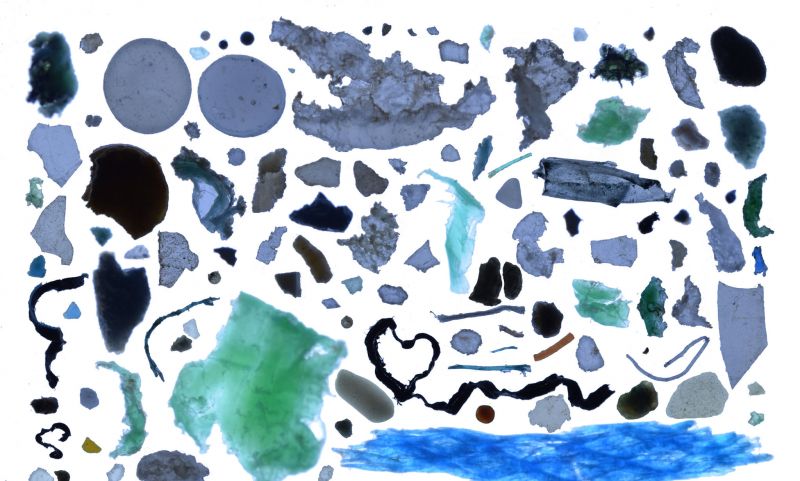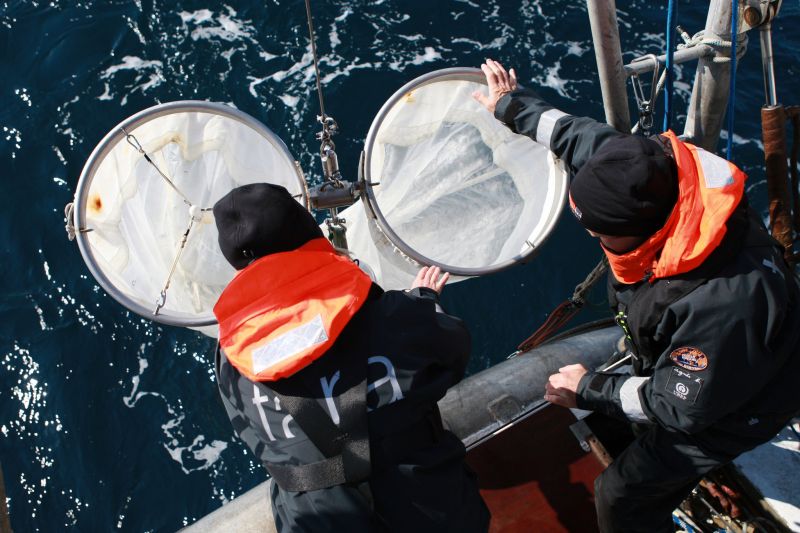Trillions of Plastic Bits Are Littering Arctic Waters
Published on by Water Network Research, Official research team of The Water Network in Academic
The world’s oceans are littered with trillions of pieces of plastic — bottles, bags, toys, fishing nets and more, mostly in tiny particles — and now this seaborne junk is making its way into the Arctic.

A photo collage of plastic fragments found in the Arctic Ocean by the research team. Credit: Andres Cozar
In a study published in Science Advances, a group of researchers from the University of Cádiz in Spain and several other institutions show that a major ocean current is carrying bits of plastic, mainly from the North Atlantic, to the Greenland and Barents seas, and leaving them there — in surface waters, in sea ice and possibly on the ocean floor.
Because climate change is already shrinking the Arctic sea ice cover, more human activity in this still-isolated part of the world is increasingly likely as navigation becomes easier. As a result, plastic pollution, which has grown significantly around the world since 1980, could spread more widely in the Arctic in decades to come, the researchers say.
Andrés Cózar Cabañas, the study’s lead author and a professor of biology at the University of Cádiz, said he was surprised by the results, and worried about possible outcomes.
“We don’t fully understand the consequences the plastic is having or will have in our oceans,” he said. “What we do know is that this consequences will be felt at greater scale in an ecosystem like this” because it is unlike any other on Earth.
Every year, about 8 million tons of plastic gets into the ocean, and scientists estimate that there may be as much as 110 million tons of plastic trash in the ocean. Though the environmental effects of plastic pollution are not fully understood, plastic pollution has made its way into the food chain. Plastic debris in the ocean was thought to accumulate in big patches, mostly in subtropical gyres — big currents that converge in the middle of the ocean — but scientists estimate that only about 1 percent of plastic pollution is in these gyres and other surface waters in the open ocean.
Another model of ocean currents by one of the study’s authors predicted that plastic garbage could also accumulate in the Arctic Ocean, specifically in the Barents Sea, located off the northern coasts of Russia and Norway, which this study demonstrates.

Scientists aboard the research vessel Tara lower nets into the water to collect
plankton and microplastics. Credit: Anna Deniaud/Tara Expeditions Foundation
The surface water plastic in the Arctic Ocean currently accounts for only about 3 percent of the total, but the authors suggest the amount will grow and that the seafloor there could be a big sink for plastic.
This particular part of the ocean is important in the thermohaline circulation, a deepwater global current dictated by differences in temperature and salinity around the world. As that current brings warm surface water up to the Arctic, it seems to be bringing with it plastic waste from more densely populated coastlines, dumping the now-fragmented pieces of plastic in the Arctic, where landmasses like Greenland and the polar ice cap trap them.
The scientists sampled floating plastic debris from 42 sites in the Arctic Ocean aboard Tara, a research vessel that completed a trip around the North Pole from June to October 2013, with data from two additional sites from a previous trip. They scooped up plastic debris and determined the concentration of particles by dividing the dry weight of the plastic collected, excluding microfibers, by the area surveyed.
Almost all of the plastic, measured by weight, was in fragments, mostly ranging from 0.5 millimeters to 12.6 millimeters. The rest of the plastic appeared in the form of fishing line, film or pellets. This mix of plastic types is roughly consistent with the kinds of plastic that collect in the subtropical gyres, though those parts of the ocean amasses a higher concentration of fishing line.
Read full article: New York Times
Media
Taxonomy
- Contaminant Removal
- Ecosystem Management
- Marine
- Oceanographic Survey
- Plastic Parts
- Waste Disposal
- Pollution